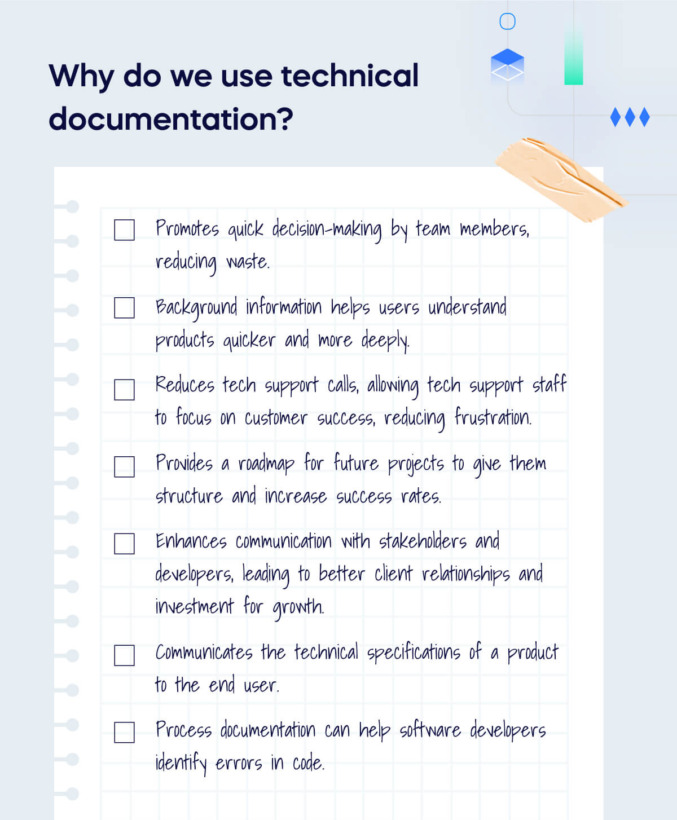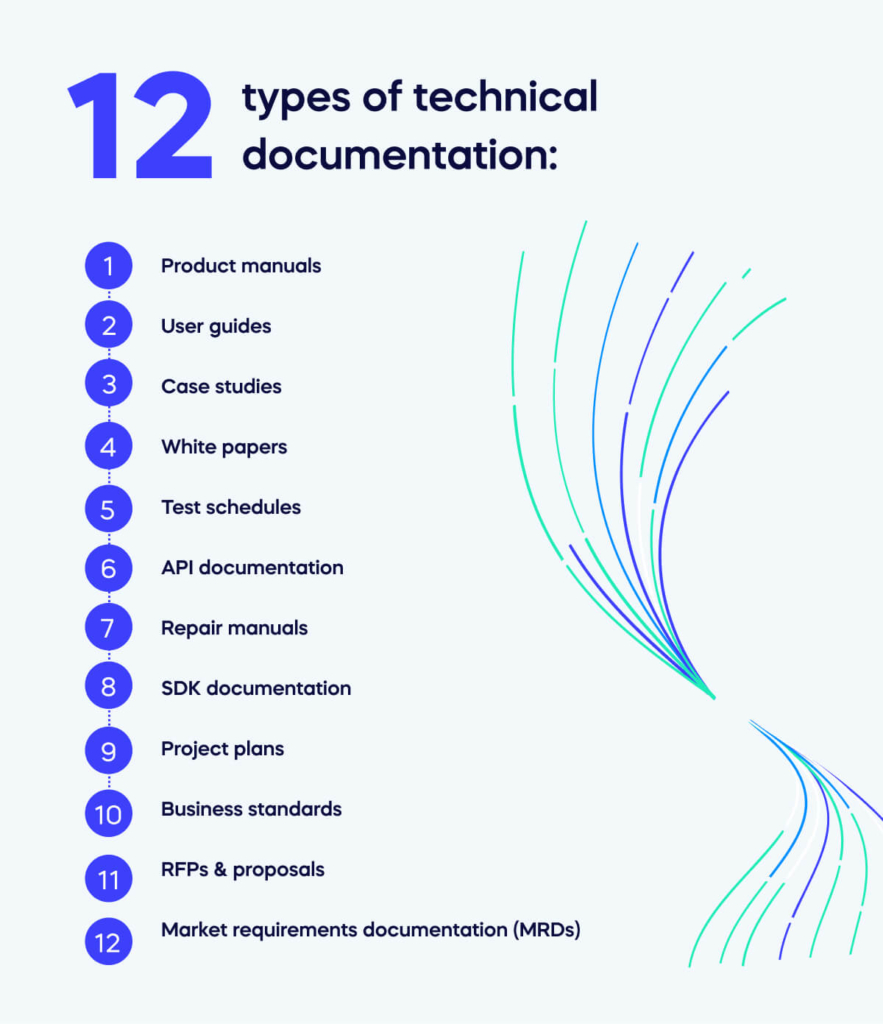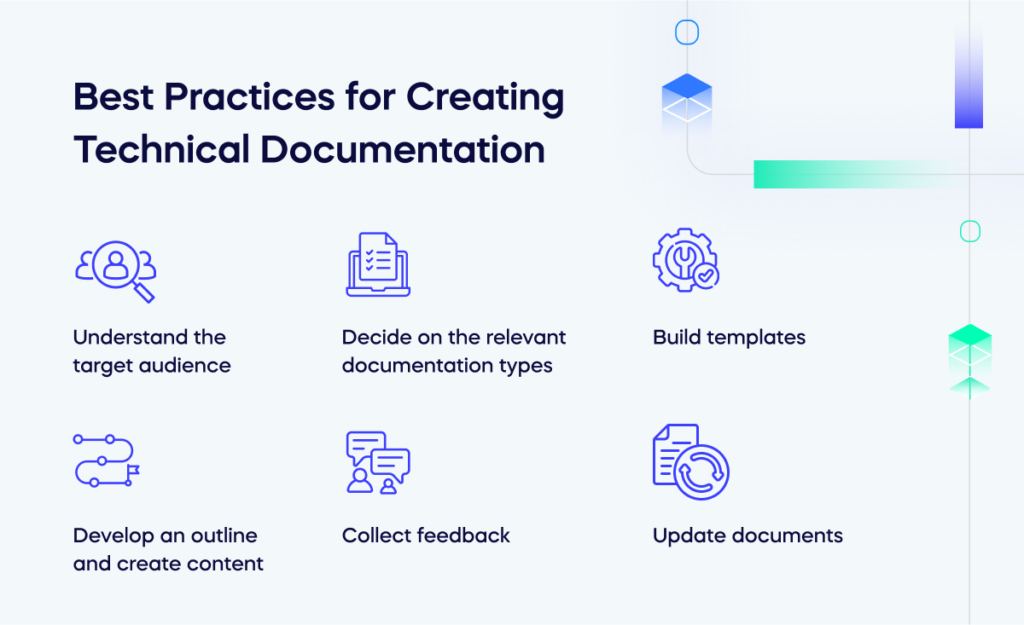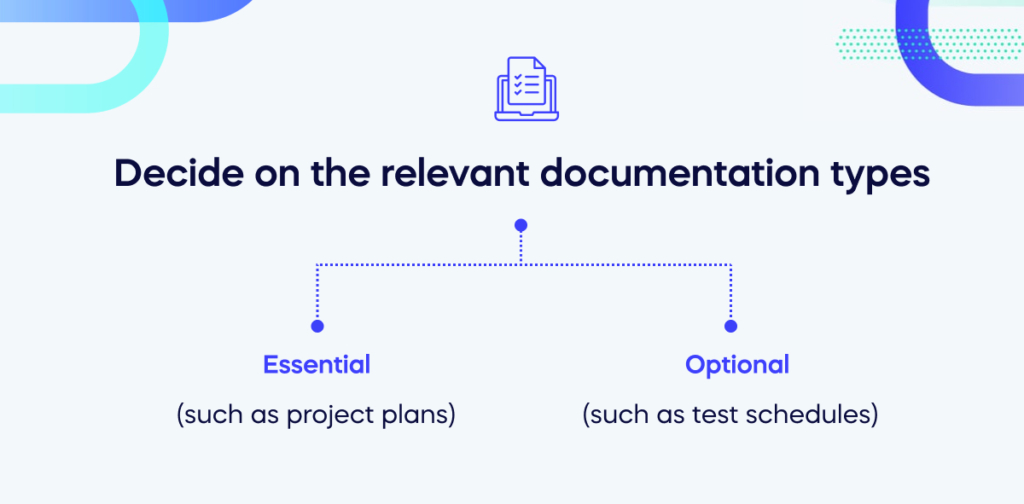Technical documents serve various purposes, but most create an important relationship between customers and your products by explaining how to use them, creating excellent customer engagement.
Technical documentation refers to documents that provide users with information on interacting with a product.
User documentation is essential to ensure users have the best experience, and many types of technical documentation serve different purposes.
We will walk you through technical documentation via the following topics:
- Why do we use technical documentation?
- What are the 12 types of technical documentation, with examples?
- Best Practices for Creating Technical Documentation
Why do we use technical documentation?

We use technical documents for many reasons, starting with the fact that it promotes efficient, data-driven decision-making.
The reasons we use and create technical documentation include the following:
- Promotes quick decision-making by team members, reducing waste.
- Background information helps users understand products quicker and more deeply.
- Reduces tech support calls, allowing tech support staff to focus on customer success, reducing frustration.
- Provides a roadmap for future projects to give them structure and increase success rates.
- Enhances communication with stakeholders and developers, leading to better client relationships and investment for growth.
- Communicates the technical specifications of a product to the end user.
- Process documentation can help software developers identify errors in code.
It is helpful to know the reasons for using and writing technical documentation to ensure it is necessary for your organization and to optimize its use in each form and purpose.
What are the 12 types of technical documentation, with examples?

Understanding the purpose of all 12 types of technical documentation can feel overwhelming. We have looked at each individually with clear explanations and examples.
Understanding these 12 types of technical documentation is essential to helping you ensure you communicate the correct information to your customers about your products and services to promote satisfaction as part of an outstanding customer experience.
1. Product manuals
Source: IKEA
Industries: Manufacturing, retail.
What it does: Explains the location, function, and purpose of a product’s parts and how to construct a product.
Examples: Instructions for IKEA flat pack furniture.
How to:
To create product manuals, decide what the manual will cover, create appropriate illustrations for the sections that need them, and write clear explanations of each step in the process.
2. User guides
Industries: Manufacturing, retail, business.
What it does: A user manual explains how to use a product, often with a list of features and their purpose.
Examples: Software guide for a new business app in employee onboarding.
How to:
Use straightforward language and demonstrations in your user documentation to explain complex features and address common issues to make them accessible for beginners to understand.
3. Case studies
Industries: Business, retail.
What it does: Promotes a product by explaining how it helped a client.
Examples: Clients of the WalkMe DAP describe how it helped them increase digital adoption rates.
How to:
To create a case study, interview a current or previous customer. During the interview, ask questions that can provide concrete data to demonstrate the results achieved by your company.
Additionally, document the customer’s individual story of their challenges before using your product and how your product brought about a positive change.
4. White papers
Source: Visme
Industries: Business, academia.
What it does: Contains research on a topic to allow an organization to become a thought leader in a subject field and to promote a product.
Examples: A white paper commissioned by OpenAI on using ChatGPT in business could promote the diverse ways companies could use it to encourage them to invest in Open AI’s other products.
How to:
To ensure your white paper is practical, concentrate on providing value through original data and expert analysis rather than focusing on your product. Although they do not include a direct sales pitch, white papers are helpful for marketing as they help to establish brand trust.
5. Test schedules
Source: Javatpoint
Industries: Software development.
What it does: Test schedules are used in software testing to outline the steps, tasks, dates, and responsibilities involved in the software testing process.
Examples: Any new business app will use test schedules to ensure it functions correctly before retail release.
How to:
To create a clear test schedule, first develop a test plan that outlines the process for reviewing, tracking, and approving tests. Then, specify exact dates, such as release and beta entry dates.
6. API documentation
Source: Paligo
Industries: Software development.
What it does: The API documentation details how developers can use the API (application programming interface) to integrate your product with others.
Examples: Dropbox is a great example of API documentation done right, as it contains an authentication guide, quick start guide, endpoint definitions, code snippets, and example responses.
How to:
To create API documentation effectively, consider both the benefits clients will get from your product (business value) and the technical details of API usage. Doing so involves adding information about the API’s functions, classes, arguments, and return types to your documentation.
7. Repair manuals
Source: 9to5mac
Industries: Manufacturing, retail, software development.
What it does: Repair manuals provide instructions on fixing a damaged product and help customers resolve hardware problems or other issues.
Examples: Even Apple, whose products are not easy to repair, provides Self Service Repair manuals to allow experienced customers to repair their products.
How to:
Anticipate all possible types of product damage that customers may encounter and provide instructions on how to solve them quickly using clear and concise instructions.
8. SDK documentation
Source: x9ware
Industries: Software development.
What it does: SDK (software development kit) documentation guides developers when building apps for a specific product or platform as part of the software documentation process.
Examples: A few examples of SDK documentation are the iPhone SDK, MacOS X SDK, Java development kit (JDK), and Windows 7 SDK.
How to:
To create documentation for your product’s software development kit, you must gather resources, including tools, compilers, debuggers, code examples, and APIs.
9. Project plans
Source: Venngage
Industries: Business, finance.
What it does: Project plans outline a project’s goals and objectives and provide a roadmap for achieving them.
Examples: Many organizations make project plans as part of a digital transformation.
How to:
At the beginning of a project, project managers create plans for tasks like introducing new accounting software or building a new computer program.
10. Business standards
Source: templatelab
Industries: Business.
What it does: Business standards refer to the rules, guidelines, and benchmarks your company must comply with in various areas, such as customer service, quality, and operations.
Examples: Product-Based Standards are used for car airbags, washing machines, and banking cards, and Performance-Based Standards are used in toy safety and greenhouse gas emissions.
How to:
To establish your company’s business standards, you should define your company’s values, outline how your employees should respond to situations in line with your values, and set the organization’s benchmarks.
11. RFPs & proposals
Source: rfp360
Industries: Business.
What it does: An RFP (request for proposal) is a document to announce a project and invite bids. In contrast, proposals are documents that persuade customers or investors to purchase a product or service.
Examples: Agency RFPs, communications consultant RFPs, and branding RFPs.
How to:
Companies utilize both RFPs and proposals to attract the ideal business partners, whether they are vendors, investors, or customers. In both documents, it is essential to include key points such as the project overview, company background, project scope, and goals.
12. Market requirements documentation (MRDs)
Source: Shootthecurlmarketing
Industries: Business.
Characteristics: Market requirements documents (MRDs) offer a detailed summary of your potential customers, their unique requirements, and the competition in the market.
Example: Any app designed to assist non-technical analysts and researchers in compiling data from multiple sources and producing informative reports will contain MRD documentation.
How to:
To create an MRD, you need to gather information about customer problems and the reasons behind those problems. This requires data such as the market problem, market opportunity, customer demographics, and use cases.
Best Practices for Creating Technical Documentation

Show these best practices to your technical writers to guide them in creating great technical documentation for your customers.
Understand the target audience
To ensure your instructions are clear when writing technical documents, determine your target audience.
Technical documentation meant for internal teams will differ in tone and content compared to documentation intended for external users, so identify the intended users of the document, their requirements, and the information they need before you begin drafting it.
Decide on the relevant documentation types

Select the types of documents you need to produce to create adequate technical documentation. Avoid including too many documents, but ensure you have enough relevant ones to make the project successful.
To simplify it, you can classify your options as essential (such as project plans) and optional (such as test schedules).
Build templates
After identifying the types of documentation you need to develop, creating a separate template for each class is advisable. It’s best to use standardized templates for different documents so that users will quickly recognize the document they need.
For instance, all your product requirements documents should have similar content sections and follow the same design format. This promotes a consistent user experience.
Develop an outline and create content
Once you have finished designing the template, proceed to write the content. The template provides a structure of what you should include, so this step involves adding details to each section.
Try to avoid duplicating efforts in this step. You might have existing resources that are suitable for referencing. Additionally, ensure your content is clear, brief, and correct with interactive elements and diagrams.
Collect feedback
To ensure your technical documentation is helpful for your teams and customers, getting feedback from key stakeholders during the development process is important. Your audience can provide valuable insights on whether your product documentation meets their needs regarding information and context.
Update documents
It is crucial to review and update your technical documentation regularly. This is particularly important if there have been any changes to your product’s functionality, such as updates or new features. To avoid confusion, your user guides and documentation should always match the latest version of your software or product.
Use a DAP to support your technical documentation efforts
Use a DAP (digital adoption platform) to bolster and enhance your technical documentation endeavors. A DAP is a valuable tool for streamlining the onboarding process and increasing user engagement with your documentation.
By integrating a DAP into your technical documentation strategy, you can provide interactive and personalized guidance to users, ensuring they fully comprehend and utilize your product or service.
The DAP offers contextual assistance, step-by-step walkthroughs, and interactive tutorials, enabling users to navigate complex technical documentation effortlessly.
Incorporating a DAP into your technical documentation approach can revolutionize how users interact with your product or service, making it an indispensable asset for driving user adoption and success.


